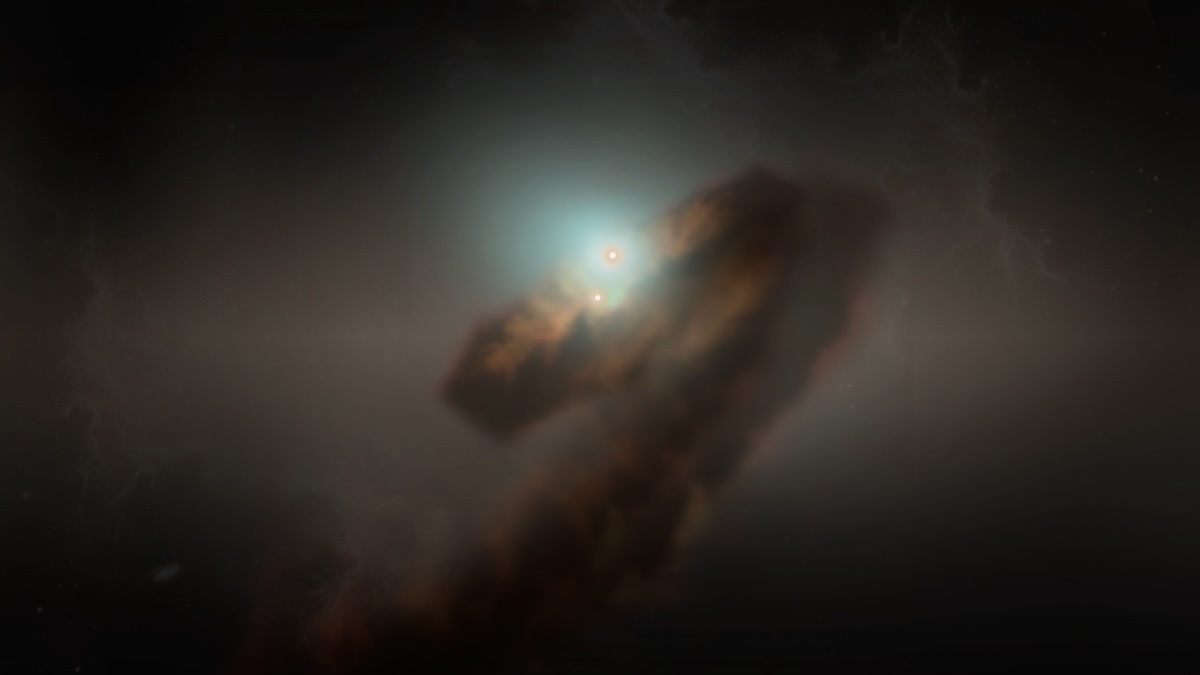3.05.2024
"FU Ori has been devouring material for almost 100 years to keep its eruption going. We have finally found an answer to how these young, outbursting stars replenish their mass."
Astronomers have puzzled for 88 years about how a pair of binary stars have continued to erupt over the course of a century, but it seems the mystery has finally been solved.
The double star system FU Orionis (FU Ori), located around 1,500 light-years from Earth in the constellation of Orion, first stunned astronomers in 1936 when it suddenly increased in brightness by around 1,000 times. This type of explosive brightening was expected from old dying stars, but the stars of FU Ori are just an estimated 2 million years old, mere infants in cosmic terms and compared to our middle-aged 4.6 billion-year-old star, the sun.
Now, a team of researchers has used the Atacama Large Millimeter/submillimeter Array (ALMA), a cluster of 66 radio telescopes located in Northern Chile, to determine why and how this happens.

Artist's impression of the large-scale view of FU~Ori. The image shows the outflows produced by the interaction between strong stellar winds powered by the outburst and the remnant envelope from which the star formed. The stellar wind drives a strong shock into the envelope, and the CO gas swept up by the shock is what the new ALMA revealed. (Image credit: NSF/NRAO/S. Dagnello)
The discovery of FU Ori's outburst led to the classification of an entirely new type of star, FUor stars, which brighten suddenly and then fade over the course of many years. Scientists have found this explosive brightening is the result of FUors stealing energy from their surroundings via the same process that helps stars and planets form: The gravitational accretion of material.
"FU Ori has been devouring material for almost 100 years to keep its eruption going. We have finally found an answer to how these young outbursting stars replenish their mass," Antonio Hales, team leader and scientist with the National Radio Astronomy Observatory (NRAO) said in (videoa statement. "For the first time, we have direct observational evidence of the material fueling the eruptions.
"We have been studying FU Orionis since ALMA's first observations in 2012. It's fascinating to finally have answers."
The team's "smoking gun" is a tendril of material, mostly carbon monoxide, that is falling on the stars FU Ori. While this thin stream of gas is currently feeding the stars, it isn't substantial enough to account for 100 years of eruptions and brightening from this system.
Thus, the team theorizes that what they see today with ALMA is the remnants of a much larger supply of matter that once fell into this young star system.
"It is possible that the interaction with a bigger stream of gas in the past caused the system to become unstable and trigger the brightness increase," Hales continued.

An illustration of the FU Ori binary system and the newly discovered accretion streamer showing the newly discovered streamer constantly feeding mass from the envelope into the binary system. (Image credit: NSF/NRAO/S. Dagnello)
To see different emissions from this star system and to detect mass flowing into it the team observed FU Ori with several different configurations of the 66 positionable radio antennas in the Atacama Desert that comprise ALMA. They also used numerical models to simulate the flow of gas to these erupting infant stars.
"We compared the shape and speed of the observed structure to that expected from a trail of infalling gas, and the numbers made sense," said team member Aashish Gupta, a Ph.D. candidate at European Southern Observatory (ESO) who devised how to model the stream of matter feeding FU Ori.
In addition to spotting the tendril of matter flowing into FU Ori, the team also saw an outflow of slowing-moving carbon monoxide passing from FU Ori. This gas doesn't seem to be associated with a recent outburst from the system.
The outflow seems to resemble other outflows that have been associated with protostars, infant stars that haven't yet gathered enough mass from their surroundings to trigger the nuclear fusion of hydrogen to helium in their cores, the process that defines a main sequence star.
"By understanding how these peculiar FUor stars are made, we're confirming what we know about how different stars and planets form. We believe that all stars undergo outburst events," Hales concluded. "These outbursts are important because they affect the chemical composition of the accretion discs around nascent stars and the planets they eventually form."
The team's research is published on Monday (April 29) in the Astrophysical Journal.
Quelle: SC
